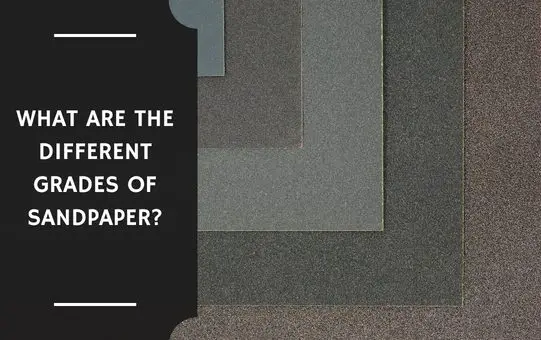When it comes to sanding a surface, there are many different grades of sandpaper available. Each grade has its own unique characteristics and is designed to be used for a specific purpose.
What Are the Different Grades of Sandpaper?
There are five grades of sandpaper, with the most coarse being the first, and the finest being the fifth. First-grade sandpaper is the coarsest and is best for quickly removing roughed-up areas or for sanding large surfaces.
In this article, we will discuss the different grades of sandpaper and their uses.
See Also: Can I Use Sandpaper on My Feet?
What Are the Different Grades of Sandpaper? – Guide
Sandpaper is a critical tool for many projects, from woodworking to automotive repair.
But did you know that not all sandpaper is the same? Depending on your project, you may need different grades of sandpaper to get the job done.
In this guide, we’ll take a look at the different grades of sandpaper available and how to choose the right one for your project. So, let’s get started and learn more about sandpaper grades!
Understanding Sandpaper Grades
Sandpaper is classified by its “grit,” which refers to the number of abrasive particles per square inch of sandpaper.
The higher the grit number, the finer the abrasive particles and the smoother the finish.
Conversely, the lower the grit number, the coarser the abrasive particles and the rougher the finish.
Coarse Grades of Sandpaper
Coarse grades of sandpaper are typically used for rough sanding tasks, such as removing paint or varnish from a surface.
The coarsest grades of sandpaper are 40-grit and 60-grit, which have large abrasive particles and will quickly remove material from a surface.
These grades are typically used for heavy-duty sanding tasks on rough surfaces, such as wood, metal, or concrete.
Medium Grades of Sandpaper
Medium grades of sandpaper are commonly used for smooth surfaces, such as preparing wood for painting or refinishing furniture.
The most common medium grades of sandpaper are 80-grit and 120-grit. These grades have smaller abrasive particles than coarse grades, which allows for a smoother finish.
Medium grades are also used for removing small imperfections in a surface and preparing it for finer sanding.
Fine Grades of Sandpaper
Fine grades of sandpaper are used for finishing surfaces, such as preparing a surface for a final coat of paint or stain.
The most common fine grades of sandpaper are 220-grit and 320-grit. These grades have very small abrasive particles that remove only a small amount of material from a surface.
Fine grades are also used for smoothing out any imperfections left by the previous sanding.
Ultra-Fine Grades of Sandpaper
Ultra-fine grades of sandpaper are used for the final stages of sanding and for achieving a smooth, polished finish.
The most common ultra-fine grades of sandpaper are 400-grit and 600-grit. These grades have extremely small abrasive particles and are used for final sanding before applying a finish.
Ultra-fine grades are also used for sanding between coats of finish to create a smooth surface.
What Is the Difference Between Sandpaper Grades?
The difference between sandpaper grades is primarily in the size of the abrasive particles that are used to make the sandpaper.
Sandpaper is classified according to its “grit,” which refers to the number of abrasive particles per square inch of sandpaper.
The higher the grit number, the finer the abrasive particles and the smoother the finish.
Conversely, the lower the grit number, the coarser the abrasive particles and the rougher the finish.
For example, 40-grit sandpaper will have larger abrasive particles compared to 220-grit sandpaper.
Coarse grades of sandpaper are used for rough sanding tasks, such as removing paint or varnish from a surface.
The coarsest grades of sandpaper are 40-grit and 60-grit, which have large abrasive particles and will quickly remove material from a surface.
Medium grades of sandpaper are commonly used for smooth surfaces, such as preparing wood for painting or refinishing furniture.
The most common medium grades of sandpaper are 80-grit and 120-grit. These grades have smaller abrasive particles than coarse grades, which allows for a smoother finish.
Fine grades of sandpaper are used for finishing surfaces, such as preparing a surface for a final coat of paint or stain.
The most common fine grades of sandpaper are 220-grit and 320-grit. These grades have very small abrasive particles that remove only a small amount of material from a surface.
Fine grades are also used for smoothing out any imperfections left by the previous sanding.
Ultra-fine grades of sandpaper are used for the final stages of sanding and for achieving a smooth, polished finish.
The most common ultra-fine grades of sandpaper are 400-grit and 600-grit. These grades have extremely small abrasive particles and are used for final sanding before applying a finish.
Ultra-fine grades are also used for sanding between coats of finish to create a smooth surface.
Conclusion
Choosing the right grade of sandpaper is important to achieve the desired finish for your project.
Coarse grades are best for heavy-duty sanding tasks, while medium grades are used for smoothing surfaces and removing small imperfections.
Fine grades are used for finishing surfaces, and ultra-fine grades are used for achieving a smooth, polished finish.
By understanding the different grades of sandpaper and their uses, you can select the right sandpaper for your project and achieve a professional-looking finish.
See Also: How Much Does Sandpaper Cost?
